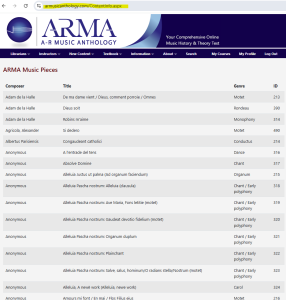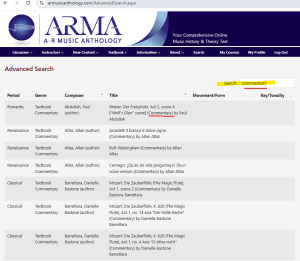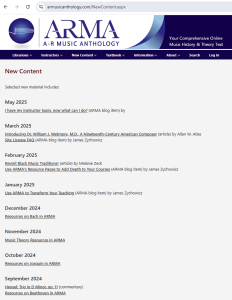ARMA’s content offers much more than possible in print, including music scores, peer-reviewed articles, and structured commentaries. In addition, ARMA also includes other materials for instructors to use with their students, like a glossary and other, similar resources. Yet instructors sometimes have questions about content, and this FAQ addresses common queries about this aspect of ARMA.
How much material is in ARMA?
ARMA contains more than 7,000 pages of material and that breaks down as follows:
- 630+ music scores
- 55+ peer-reviewed article
- 135+ structured commentaries
ARMA also has content guides and resource pages for instructors to use in their courses. Additional material is in preparation, including new articles on various topics.
How does ARMA work? My students cannot find the open button and sometimes see just one page of a score.
All content opens in ARMA when you click on the item in your courses or on search results. If your students see just one page, it’s likely that they are not logged into ARMA. Logins allow users to view and print the score, articles, and commentaries in ARMA.
How much content do students see?
The student login opens to the page for your course, and students can click on any item to open it. In addition to your course materials, students can use the search bar to explore ARMA for assignments instructors give or to find more information at the site.
Isn’t all the content in ARMA already in Recent Researches and RRIMO?
ARMA’s content differs from Recent Researches and RRIMO with its focus on music scores used in teaching music history and theory. The contents represent the usual pieces that instructors include in their courses. Since instructors also use Recent Researches material in their courses, ARMA includes selections, but the overlap between the two publications is small. For details about ARMA, use the search utility to explore ARMA, or consult the content list.

Isn’t ARMA limiting when compared to IMSLP and other databases?
ARMA’s focus is content that supports music history and theory courses, including surveys, period courses, courses on music literature, and other, related purposes. Yet instructors who need specific pieces can always contact us about requesting new items for ARMA.
Aren’t the articles in ARMA just reprints from other sites?
No, the articles in ARMA are not reprints. Rather, they are peer-reviewed articles unique to ARMA and not available elsewhere. The articles range between 5,000 to 15,000 words and include extensive footnotes, as well as an interactive bibliography (with links to WorldCat). The articles are peer-reviewed, with the musicologists on the ARMA board reviewing submissions, along with outside readers. Some authors remind comment on the thoroughness and appreciate the ways in which their contributions benefit from the editorial review.
What’s different about the commentaries in ARMA compared with the ones in bound books?
Unlike some commentaries in print that are limited by the space available between music scores, ARMA’s commentaries are free of spatial limitations. The result is a structure that includes:
- Identify the piece
- Establish its context
- Discuss the structure of the work and its features
- Confirm the reasons for including this piece in ARMA.
Commentaries are available as readings for courses and also appended to the scores they cover.

How do I learn about new content?
In addition to searching ARMA directly, the New Content page lists additional materials in ARMA chronologically from the most recent to the oldest. New content includes music scores, articles, commentaries, blog posts, and other materials in ARMA. Use the page to make certain that your courses have all the latest material.

More questions?
Sometimes the information in FAQs prompts more questions, so we invite you to contact us whenever you need to know more about the reasons to use ARMA for your courses.

